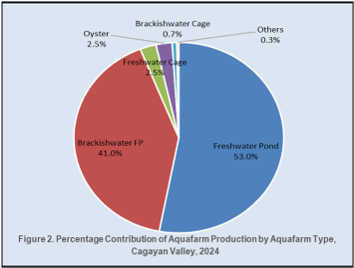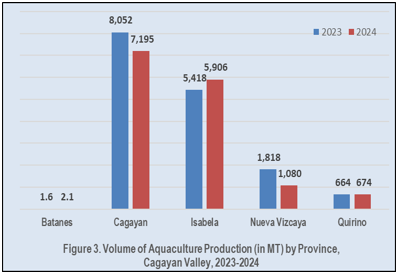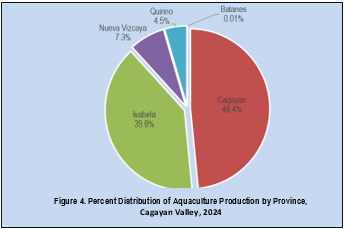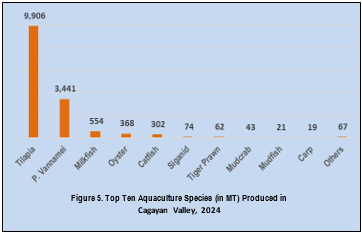Explanatory Notes
This Special Release presents the aquaculture fisheries production statistics of Cagayan Valley for the year 2024. It provides a comprehensive analysis of aquaculture production in the region, with comparisons to the 2023 level. The data cover total production volume, contributions by aquafarm type, provincial outputs, and species production levels. The statistics featured in this report are based on the latest available results from the Quarterly Aquaculture Survey (QAqS), spearheaded by the Fisheries Statistics Division of the Economic Sector Statistics Service under the Sectoral Statistics Office of the Philippine Statistics Authority (PSA).These data were sourced from the PSA’s official statistics database at www.openstat.psa.gov.ph.
Aquaculture production in 2024 recorded a total output of 14,857 metric tons, reflecting a 6.9 percent decline compared to the 15,954 metric tons produced in 2023. This overall decrease was attributed to the reduction in output from several major aquafarm types, particularly from freshwater fishpond, brackish water fishpond, and oyster farms.

The freshwater pond remained the leading aquafarm type in terms of production volume. However, it experienced a decline of 3.1 percent, from 8,125 metric tons in 2023 to 7,877 metric tons in 2024. Despite this decrease, it continued to contribute the largest share to total aquaculture output, showing its importance in the region's aquaculture industry.
Production from brackish water fishponds, the second-largest contributor, also fell by 8.3 percent, from 6,650 metric tons in 2023 to 6,096 metric tons in 2024. This marked decline significantly impacted the total regional output, given the substantial volume this aquafarm type contributes annually.
A sharp drop was recorded in oyster production, which plummeted by 43.7 percent, from 653 metric tons in 2023 to only 368 metric tons in 2024. This notable decline was due to environmental factors, such as water salinity changes caused by dry spell and series of typhoons that hit the region in 2024 which affected its yields.
Freshwater cage operations also posted a decrease of 5.4 percent, from 391 metric tons in 2023 to 370 metric tons in 2024.
On the other hand, some aquafarm types posted increases in production. Brackishwater cage production rose by 11.5 percent, from 96 metric tons in 2023 to 107 metric tons in 2024. Likewise, small farm reservoirs showed an increase of 26.1 percent, which rose from 23 metric tons in 2023 to 29 metric tons in 2024, although its overall contribution to total output remained relatively small.
Meanwhile, new or marginal entries in aquaculture were noted in brackishwater pens, freshwater pens, and rice fish production, all of which recorded minimal outputs in 2024.

For the year, freshwater pond culture remained the leading contributor to aquaculture production in Region II, accounting for a substantial 53.0 percent share of the total output. Following closely was brackishwater fishpond, which contributed 41.0 percent to total production. While slightly lower than freshwater pond, this type still plays a crucial role, particularly in coastal provinces where brackish environments are favorable for species such as milkfish and tilapia.
The third and fourth highest contributors were freshwater cage culture (2.5 percent) and oyster farming (2.5 percent), respectively. These aquafarm types, while minor in scale compared to pond culture systems, reflect the growing diversification of aquaculture activities in the region.
Brackishwater cage culture ranked fifth, contributing 0.7 percent to the total. Though still a relatively small portion, this method has potential for growth, especially with advancements in cage technology.
The "Others" category, which includes all remaining aquafarm types not individually listed, accounted for just 0.3 percent of production. During the year, Aquaculture production across the provinces of Region II displayed mixed performance, with some provinces registering increases while others saw declines compared to the previous year.

Isabela emerged as the top-performing province in 2024, with its production reaching 5,906 metric tons, an increase of 9.0 percent from 5,418 metric tons in 2023. This notable growth reflects ongoing efforts to improve aquaculture operations and possibly favorable conditions for fish farming during the year. Cagayan, while still the leading producer, experienced a decline of 10.6 percent, with production falling from 8,052 metric tons in 2023 to 7,195 metric tons in 2024. Despite the decrease, it remained a significant contributor to the region’s overall output.
In contrast, Nueva Vizcaya posted the most significant drop in production. From 1,818 metric tons in 2023, output declined sharply by 40.6 percent to just 1,080 metric tons in 2024. Meanwhile, Quirino recorded a slight increase of 1.4 percent, with production rising from 664 metric tons to 674 metric tons. Although modest, this upward trend indicates stable aquaculture performance in the province.
Batanes, which consistently contributes a minimal share to the region’s aquaculture output, also showed improvement. Its production rose from 1.6 metric tons in 2023 to 2.1 metric tons in 2024, representing a 31.3 percent increase. While the absolute volume remains small, the growth signifies positive developments in the province’s local aquaculture activities.

In 2024, the distribution of aquaculture production across the provinces of the region remained heavily concentrated in the larger provinces, with Cagayan and Isabela accounting for the lion’s share of the region’s total output.Cagayan held the largest share, contributing 48.4 percent of the region’s total aquaculture production. Despite experiencing a year-on-year decline in output, the province remained the dominant producer. Isabela followed closely with a 39.8 percent share. This marks a significant increase in its contribution compared to the previous year.
Nueva Vizcaya, despite a significant drop in production volume, still managed to contribute 7.3 percent to the regional total. Quirino accounted for 4.5 percent of the total regional output, maintaining a relatively stable presence in the regional aquaculture landscape. While its contribution is modest compared to Cagayan and Isabela, Quirino’s steady share suggests consistent production activities and gradual growth.
Batanes, with its limited aquaculture capacity, contributed a minimal 0.01 percent. Although small, this share reflects the province’s geographical and ecological limitations, as well as its emerging efforts to participate in aquaculture development.
In terms of production by species, aquaculture production in Cagayan Valley continued to be dominated by tilapia, with an output of 9,906 metric tons (MT). This accounted for the majority share of total aquaculture production in the region, showing the region's favorable conditions for tilapia culture.

Following tilapia, P. vannamei emerged as the second most produced species with 3,441 MT, indicating a growing trend in shrimp aquaculture, due to high market demand and export potential. The shift towards high-value species such as P. vannamei suggests continued diversification in aquaculture practices.Milkfish (bangus) ranked third at 554 MT, which, despite being significantly lower than the top two species, still has strong potential for culture since its fry are sourced from the wild.
Other species such as oyster (368 MT) and catfish (302 MT) also contributed notable volumes. These are typically cultivated in smaller-scale catering mainly to local markets. Siganid (74 MT), tiger prawn (62 MT) and Mudcrab (43 MT) had modest contributions, potentially due to more specialized culture requirements or limited pond availability.
Mudfish, with a production of 21 MT, contributed a small volume despite not being intentionally cultured, as it naturally enters aquafarms.
Meanwhile, carp, one of the emerging species being cultured in the region, recorded a production of 19 MT. An additional 67 MT was recorded under “others”, which may include species like gourami, pangasius, seaweeds, endeavor prawn were cultured in limited volumes.
ENGR. GIRME M. BAYUCAN
(Chief Statistical Specialist)
Officer-in-Charge, RSSO II
/emdp/jcb
